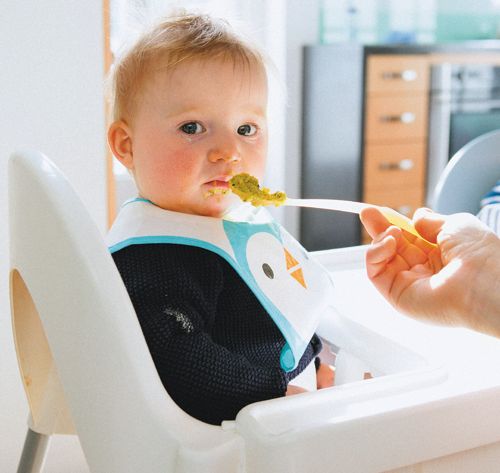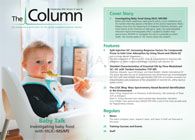Investigating Baby Food Using HILIC–MS/MS
Babies and infants experience rapid growth within a short timeframe and the nutrition that they absorb is therefore of the utmost importance. María Mateos-Vivas from the Department of Analytical Chemistry, Nutrition, and Food Science at the University of Salamanca, Spain, has used hydrophilic interaction liquid chromatography (HILIC) coupled to tandem mass spectrometry (MS/MS) to investigate the role of nucleotides on infant health. She recently spoke to The Column about this research.
Photo Credit: Matilda Delves/Getty Images

Babies and infants experience rapid growth within a short timeframe and the nutrition that they absorb is therefore of the utmost importance. María Mateos-Vivas from the Department of Analytical Chemistry, Nutrition, and Food Science at the University of Salamanca, Spain, has used hydrophilic interaction liquid chromatography (HILIC) coupled to tandem mass spectrometry (MS/MS) to investigate the role of nucleotides on infant health. She recently spoke to The Column about this research.
Q: Your group recently used hydrophilic interaction chromatography coupled to tandem mass spectrometry (HILIC–MS/MS) for baby food analysis (1). What led your group to begin this study?
A: Our group previously investigated nucleotide monophosphates in infant formulas and in human milk using capillary electrophoresis coupled to mass spectrometry (CE–MS) (2,3).
Nucleotides can be synthesized endogenously and can also be introduced into the human body as normal components of our diets, and our bodies have ways of absorbing and making use of them. These nucleotides are known as dietary nucleotides and may become essential nutrients when the endogenous supply is insufficient for normal function like during certain diseases, such as a gut injury, periods of rapid growth, when the immune system is activated, or if the protein intake decreases.
The exogenous contribution of nucleotides is relevant for babies and infants because they are in periods of rapid growth. Human breast milk is the best source of nucleotides for babies. The Scientific Committee for Food of the European Community, among other organizations, recommends the supplementation of adapted-milk formulas with nucleotide monophosphates: adenosine monophosphate (AMP), cytidine monophosphate (CMP), guanosine monophosphate (GMP), uridine monophosphate (UMP), and inosine monophosphate (IMP). According to the European regulations, five nucleotide monophosphates are permitted as supplements at a maximum concentration of 5 mg/100 kcal in food products.
Taking into account the importance of nucleotides for infant health, to control and monitor the quality of baby foods, appropriate analytical methods for their quantification are needed. We thought that it would also be interesting to analyze other types of foodstuffs in a baby’s diet, such as dairy and non-dairy foods, for babies from six months old. We decided to expand the previous study by using hydrophilic interaction liquid chromatography (HILIC), a technique highly recommended for the separation of polar compounds, coupled to tandem mass spectrometry (MS/MS). Previous studies were focused on the determination of nucleotide monophosphates (4,5,6). Our group decided to expand the determination to nucleosides and nucleotide di- and triphosphates as target analytes, in this way taking into account the interconversions that may take place between these compounds.
Different authors have reported the degradation of nucleotide di- and triphosphates to generate nucleotide monophosphates and finally, nucleosides (7–9). For this reason, we found it important to analyze the whole set of compounds including nucleosides, nucleotide mono-, di-, and triphosphates.
Q: What should the analyst consider when analyzing baby food samples?
A: Baby food samples contain nucleosides and nucleotides endogenously. Nucleotides can be found as free forms and in other nutritionally available forms like polymeric ribonucleic acids, nucleosides, and nucleotideâcontaining adducts (NAD). Accordingly, the total nucleotide content is expressed as total potentially available nucleotides (TPAN). For this reason, the first thing that should be taken into account is whether your aim is to determine the free forms or the quantification of the TPAN (free forms + polymeric forms). This fact will determine your sample treatment approach (with or without previous enzymatic digestion of the analytes) and the following clean-up because it is crucial to control the inter-transformations that may occur between the different chemical forms of nucleotides.
Q: What were the main analytical challenges you encountered in this study and how did you overcome them?
A: One of the main challenges encountered in this study was to achieve the chromatographic separation of the studied analytes, since nucleosides and nucleotides are very polar compounds that are charged to a wide range of pH. This hinders their retention on the conventional stationary phases used in reversed-phase liquid chromatography (LC). Moreover, in the analysis of phosphorylated compounds (for example, nucleotides mono-, di-, and triphosphates) by LC–MS, an interaction with specific parts of the LC–MS setup may arise. These interactions are produced by the adsorption of the analytes on silanol groups of stationary phases when working in acidic medium, or through the complexing of metallic cations (mainly iron from stainless steel or solvents) with their phosphorylated residues. To circumvent these problems, a method based on HILIC–MS/MS in the presence of hydrophilic ion-pairing reagents was proposed.
Another important aspect that should be noted is the complexity of the analyzed samples. The baby foods studied in this work contain a huge number of ingredients and a high fat and protein content. Selection of an appropriate sample treatment for extraction and matrix clean-up was a crucial step for the correct development of the method. The use of centrifugal-assisted ultrafiltration (CUF) allowed us to obtain clean extracts in a simple way and without using organic solvents.
Q: Why did you decide to use HILIC in your analysis? What does this method offer over existing methods?
A: As I mentioned before the separation of nucleosides and nucleotides by LC–MS is not an easy task. Reversed-phase LC is limited as a result of the high polarity of these compounds, and even the use of stationary phases with polar modifiers results in poor resolution because of the interactions between the phosphate groups from nucleotides and different parts of the LC–MS setup. Some authors have proposed different strategies to avoid these interactions including the use of other chromatographic modes, such as ionâpairing or ion-exchange (10,11,12). However, some of these proposals are not easy to apply and they add complexity to the overall method. Other proposals result in methods with excessively long separation times and they usually involve non-volatile reagents that are not compatible with MS. As a new approach, our group developed a rapid and efficient method based on HILIC–MS/MS achieving the separation of 20 nucleosides and nucleotides in less than 9 min. In addition, the ion-pairing reagents proposed in this work, diethylamine and hexafluoroisopropanol, have very low boiling points and are totally compatible with MS detection.
Q: Can you offer any advice to chromatographers who have never used HILIC before?
A: It is worth mentioning the advantages that HILIC offers for the separation of polar compounds, that is, allowing determinations to be performed that would not be possible using other chromatographic modes. There are also more types of HILIC stationary phases in the market nowadays, which increases analysis possibilities according to the need of each researcher. From my personal experience, I would recommend performing an extensive previous conditioning of the column as well as an exhaustive subsequent washing, even more if ion-pairing reagents or any other mobile phase additives are used. Following this protocol, a more rugged analysis and longer life times for the column are obtained, even when analyzing very complex samples like baby foods. Moreover, coupling with MS spectrometers facilitates the quantification in real samples at trace levels of polar analytes separated by HILIC.
Q: Are you planning to use HILIC in future food analysis work?
A: Based on the good results obtained in this study, and particularly considering the inherent difficulties in the separation of the nucleosides and nucleotides and the complexity of the analyzed samples, we expect HILIC–MS/MS to be our first choice for future studies in our group. We plan to focus on the use of HILIC for the determination of nucleosides and nucleotides in other foodstuffs that contain these compounds endogenously, and also on the extension of our method for the analysis of other micronutrients of interest with similar chemical characteristics.
References
- María Mateos-Vivas et al., Food Chemistry211, 827–837 (2016).
- Encarnación Rodríguez-Gonzalo et al., Electrophoresis35, 1677–1684 (2014).
- María Mateos-Vivas et al., Food Chemistry174, 348–355 (2015).
- K. Inoue et al., Journal of Agricultural and Food Chemistry58, 9918–9924 (2010).
- K. Inoue et al., Journal of AOAC International 95, 603–605 (2012).
- B.D. Gill et al., Journal of AOAC International93, 966–973 (2010).
- L. Thorell et al., Pediatric Research40, 845–852 (1996).
- C.O. Mohan et al., Innovative Food Science and Emerging Technologies10, 272–278 (2009).
- W. Verachia et al., Food Chemistry 141, 841–846 (2013).
- P. Viñas et al., Food Chemistry57, 7245–7249 (2009).
- P. Viñas et al., Journal of Chromatography A1217, 5197–5203 (2010).
- K. Inoue et al., Journal of Agricultural and Food Chemistry56, 6863–6867 (2008).

María Mateos-Vivas is a PhD student in the Department of Analytical Chemistry, Nutrition and Food Science at the University of Salamanca, Spain. Her work is focused on the development of modern and innovative analytical methods based on tandem mass spectrometry coupled to high-efficiency separation techniques, such as capillary electrophoresis and liquid chromatography. Another important part of her work is dedicated to the development of methodological innovations in liquid chromatography systems: hydrophilic interaction liquid chromatography and nanoâliquid chromatography.

Analytical Challenges in Measuring Migration from Food Contact Materials
November 2nd 2015Food contact materials contain low molecular weight additives and processing aids which can migrate into foods leading to trace levels of contamination. Food safety is ensured through regulations, comprising compositional controls and migration limits, which present a significant analytical challenge to the food industry to ensure compliance and demonstrate due diligence. Of the various analytical approaches, LC-MS/MS has proved to be an essential tool in monitoring migration of target compounds into foods, and more sophisticated approaches such as LC-high resolution MS (Orbitrap) are being increasingly used for untargeted analysis to monitor non-intentionally added substances. This podcast will provide an overview to this area, illustrated with various applications showing current approaches being employed.









